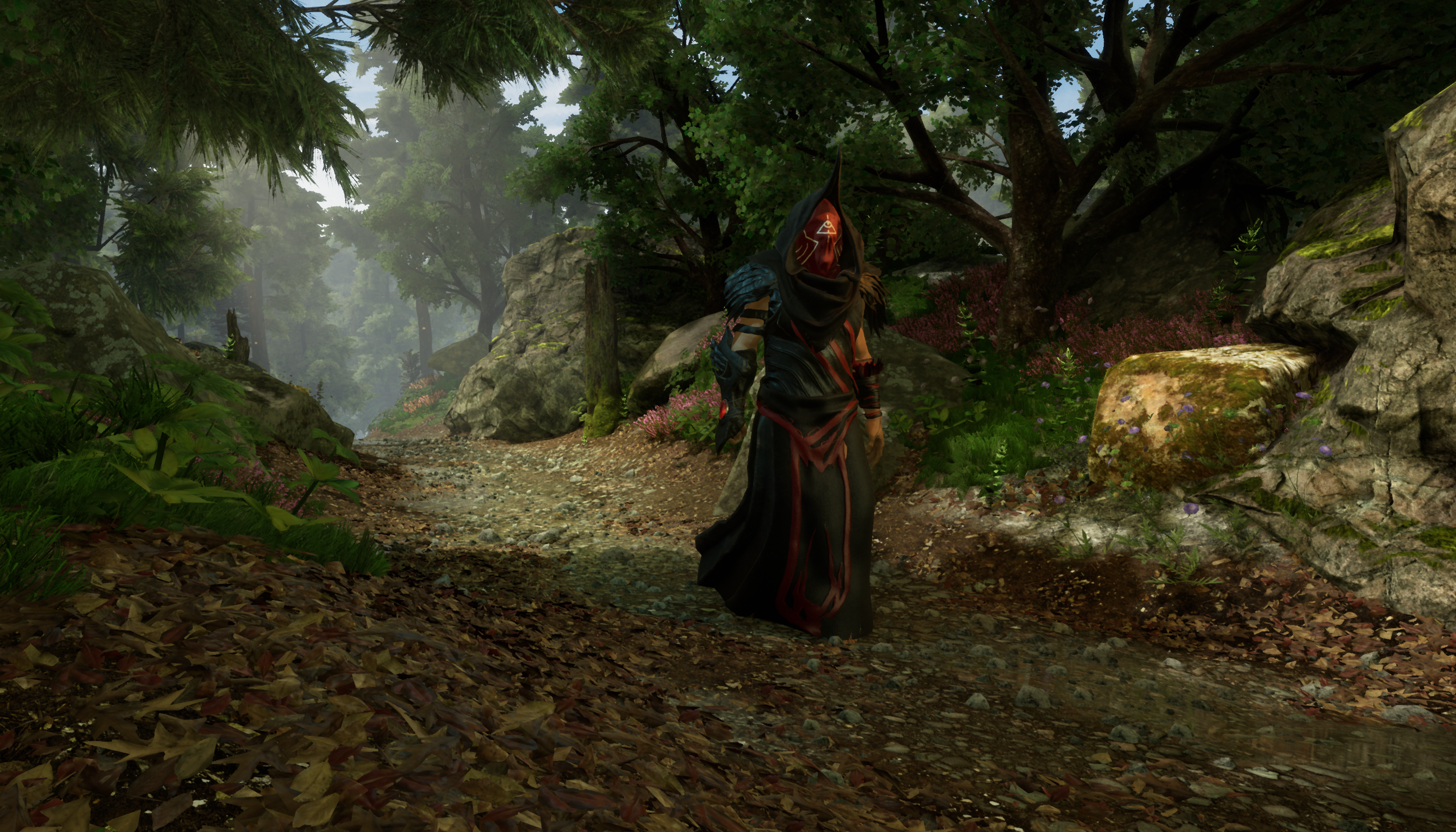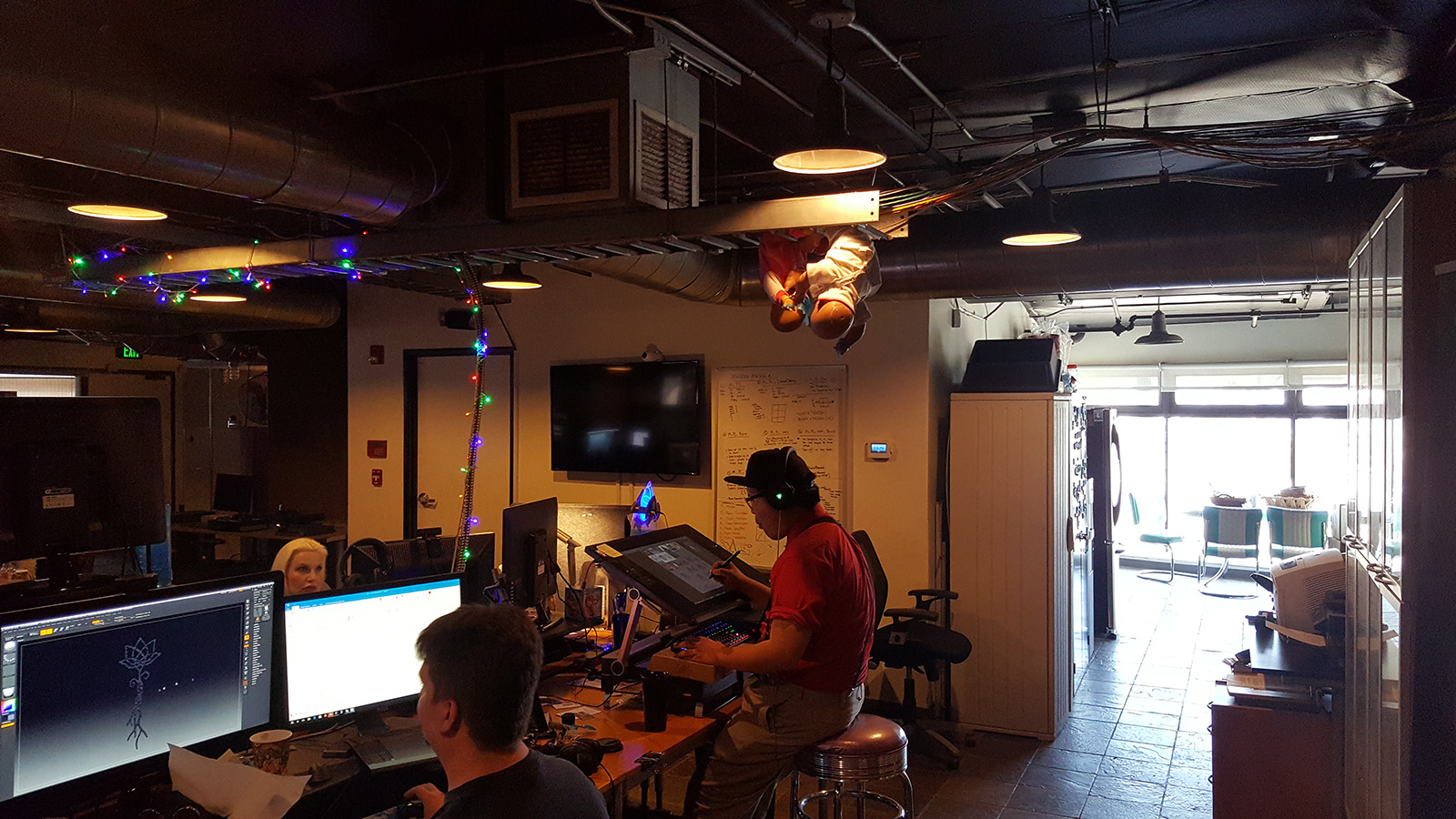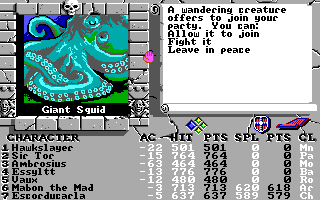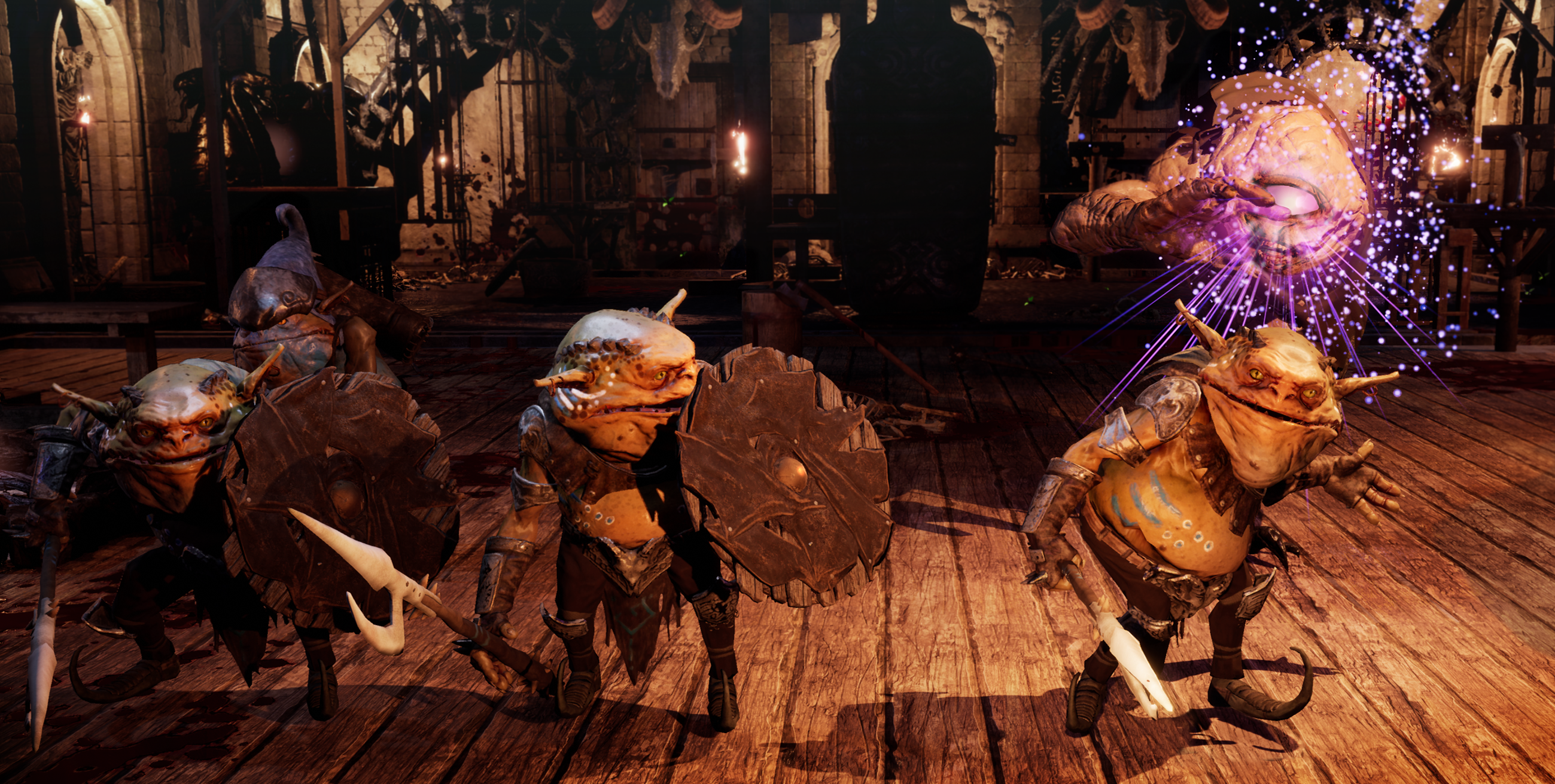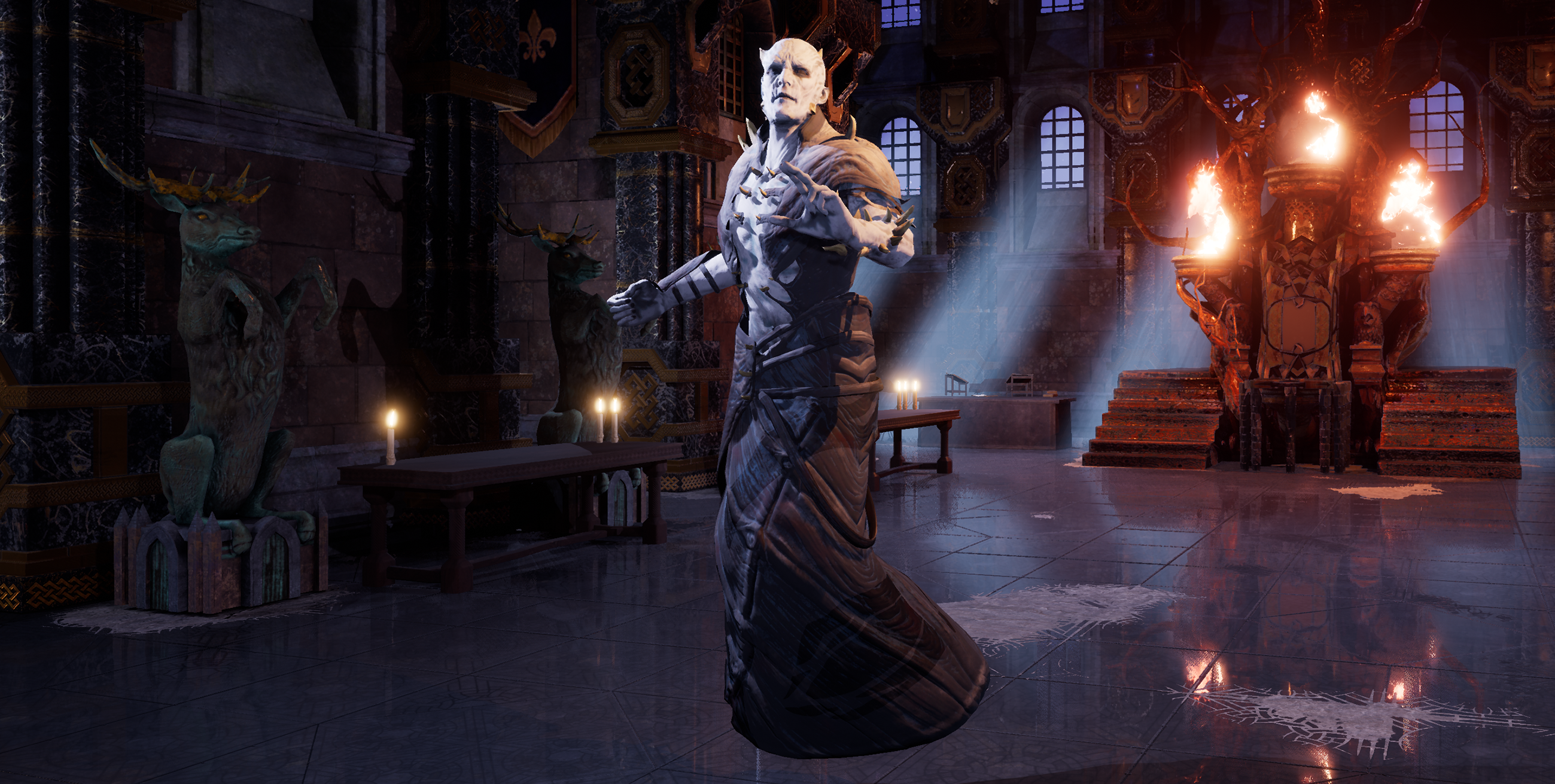The Bard's Tale 4 first look: Reinventing the dungeon crawler
We go to inXile for an exclusive inside look at Brian Fargo's return to the world of The Bard's Tale.
We're standing in the most beautiful dungeon I've ever seen in a game—which happens to be a lush green forest peppered with highlights of orange and red, not the dank catacombs I think of when I hear the word ‘dungeon.’ And when we start walking forward, peering side-to-side and climbing a set of stony stairs, there's something else odd: our free, unconstrained movement, a far cry from the rigid step-by-step, block-by-block exploration of classic dungeon crawlers. This is what it looks like to build a new game in a genre as old as PC gaming itself.
Developer inXile has invited me to its studio for an early look at The Bard's Tale 4, the first game in the series since 1991. After the blinding glare of a bright southern California morning, the inXile office, a floor above a local surf shop, feels a bit like a dungeon itself. But a cool one—it's small and intimate, decked out with Christmas lights and artwork for Wasteland 2 and only the occasional baby doll hanging from the rafters. For the next hour, I'll get to see a game that feels at once delightfully old-fashioned and tantalizingly new. The Bard's Tale 4 is the first dungeon crawler that's really grabbed my interest since I sat on my dad's lap playing the original Bard's Tale circa 1993, getting lost in the endless streets and abandoned houses of Skara Brae. Partially because, damn, is it ever pretty, but mostly because inXile is walking a tricky tightrope of nostalgia and innovation.
The Bard's Tale 4 is the first dungeon crawler that's really grabbed my interest since I sat on my dad's lap playing the original Bard's Tale circa 1993.
"We're keeping the important parts of Bard's Tale, incorporating that into a package keeping modern sensibilities in mind," says Brian Fargo, who helped design The Bard's Tale with his friend Michael Cranford in 1984. It was one of the first games developed at Interplay, which he founded in the early 1980s and left in 2000 after a corporate buyout dramatically changed the company. His team at inXile, which he founded in 2002, is small—Fargo likes to talk about them being scrappy, and finding clever ways to punch above their weight with games like The Bard's Tale 4—though they're a bit bigger than the team of a half-dozen that made The Bard's Tale one of the most popular RPGs of the 1980s.
Fargo lays out how much of this new Bard's Tale is staying true to the classic dungeon crawler formula. Party-based? Naturally. Turn-based combat? Of course. Exploration is still core to the game, and you'll be finding secret doors and treasures even when you're wandering the Forest of Inschriach, where our demo started.
"We even allow you to keep on a grid-based system," Fargo says. "There's something to be said for the precision of true-mapping. When things are just pure open world, it's a different mapping sequence than when I can know exactly what square I'm on. So that's another option here, that you can lock onto a grid and know where you are, even though it looks like free movement. Which it is—you can have it either way, basically."
Building the world of The Bard's Tale
The Bard's Tale 4 isn't the first dungeon crawler to have above-ground 'dungeons,' of course—2014's Legend of Grimrock 2 starts on a picturesque beach—but it's amazing how different a dungeon crawler feels the second you're not snapped to a grid. Creative director David Rogers explains that in level design, everything is aligned to a grid, so fans can break out the graph paper and map their own dungeons if they wish. "They can play on hardcore mode and be able to orient themselves in a dungeon, and have a sense that maybe there's a secret room behind here, because I've mapped this out and I can tell there's a gap, and I feel like there might be something behind this wall," he says.
VP of Development Chris Keenan chimes in that at the same time, it was important to them that The Bard's Tale 4 didn't look look it was on a grid. "Sometimes I've seen, like, Legend of Grimrock and those types of games, it still has that feel—everything is very squared off and angled," he said.
Keep up to date with the most important stories and the best deals, as picked by the PC Gamer team.
One thing The Bard's Tale 4 definitely has in common with other dungeon crawlers is the eerie stillness of its world. There is animation, of course: Particles float in the air, plants sway slightly in the breeze. Later, when we enter a proper dungeon beneath a castle, goblins patrol its stone hallways. But this is more like walking through a painting than the busier simulation of a world like Skyrim's or The Witcher 3's.
"When you get into a dungeon crawl experience, you don't have this really dynamic, changing environment, the frenetic feel of combat going around, constantly moving your camera," Keenan says. That's why Bard's Tale 4 is being built in Unreal Engine 4, and what I've seen running in real time looks just as nice as the little slice of gameplay video inXile has released so far.
"We want to push as much effort into the visual effects, the characters, the animation, the personality of the guys you're fighting against. A lot of the time these games can get pretty dry."
Dry wasn't a problem for The Bard's Tale 3, which involved an element of time travel and fighting enemies including Nazi soldiers and mutant bikers. The Bard's Tale 4 is unsurprisingly skipping that bit of the series' history and instead expanding on the lore surrounding the city of Skara Brae and the world of Caith, which was never fleshed out in the original trilogy.
That's a good opportunity for an early dose of nostalgia. "In the first Bard's Tale there was a map of Skara Brae and you would expand it," Fargo says. "[In Bard's Tale 4] Skara Brae is now the first dungeon. A town has been built on top of Skara Brae. If you remember what Skara Brae looked like, in the grid, it's exactly the same."
To the south of Skara Brae is the trap-infested Forest of Inschriach, with a civilization of woodpeople inspired by the Scottish Picts tribe. Skara Brae and the forest are two of the game's ‘culture centers,’ locations with their own personality and history and races. Rogers rattles off several others that will be in the game: Elves, Trow, Einarr, and Baed. Though I don't see any friendly NPCs in my demo, only enemies, they'll be in the game to talk to for quests and lore and bits of useful information.
"These are places where friendly (or at least not murderous) NPCs reside," Rogers elaborates. "This is where you shop, get quests, talk to people about local rumors, etc. Cultural centers are the one place in our game we don’t consider dungeons. They tend not to be trap-ridden or teeming with monsters. It’s a place where you can catch your breath and not worry about being jumped at every turn."
Rogers says there are more than 20 dungeons in The Bard's Tale 4, and the forest gives me a rough idea of how its world will fit together. It's made up of five dungeons "that are connected to one another, and to some extent have relationships to one another," he says. "There's the hub dungeon, and then that branches off to these other dungeons that are connected to it. And then connected to that five dungeon super-dungeon are two other dungeons that you delve into through a level load. So where one dungeon starts and where one dungeon ends, to a player might be kind of hazy, but we plan them out in discrete chunks of challenge, and each one sort of has its own narrative arc that it goes through."
We allow people to go in and get their ass kicked and kind of learn a lesson.
Chris Keenan, VP of Production
inXile wants exploration in The Bard's Tale to let you stumble upon what it calls "aspirational content," which is one of my favorite bits of game design that I've never put a name to—an alluring, insurmountable challenge discovered early on that makes you feel like you've discovered something off the beaten path. If you're bold and skilled, you can push through at a low level—like, say, braving the skeleton graveyard in Dark Souls or defeating the Midgar Zolom that prowls Final Fantasy 7's world map—but you're more likely to return 30 hours later and beat your former tormenter into the ground.
"It is nonlinear, so we allow people to go in and get their ass kicked and kind of learn a lesson," Keenan says. "Go OK, mark that on the map, make sure I come back later."
That's our cue to dive into the first live demonstration of The Bard's Tale 4's combat system inXile has shown to anyone outside the studio. We load up a new area, Castle Hangskall, and Rogers sets the stage: Tarjan, the villainous Mad God from The Bard's Tale of old, has sacked the Einarr Isles and holed up in the throne room of Castle Castle Hangskall. The King has asked you to retake it, and the ghost of a former castle worker clues you in that a key you need was dragged off to the torture chamber in the pocket of another unlucky soul. We set out to go find it.
A new take on dungeon crawler combat
Like most dungeon crawlers, you roam the halls of The Bard's Tale 4 in first person, and control and represent a whole party—up to six characters, in this case—not an individual protagonist. Once you get into combat, though, The Bard's Tale 4 does combat differently than any dungeon crawler I've seen. Suddenly it's like a mini tactics game: a 4x4 grid slides into view, and battles place a heavy emphasis on positioning. Your heroes get eight spaces, and the enemy party gets eight spaces. Every character has a 'move' ability, but some attack abilities also integrate movement.
I start to get an idea for how complex these battles could become when Rogers runs into a bumbling crowd of goblins. Combat starts and the goblins bicker with one another in an example of a 'flavor moment' inXile plans to build more of into combat. Rogers uses an ability called Passing Slash to slice one of the goblins as he moves past it.
"That's really great for focusing fire, because I get to select a target to move through, and sort of like a sword dancer they're able to leap to another position and change places with another character, putting them in position to attack," he says. "So we do a lot of positional play. I can knock enemies away, levitate and move them. There's a dagger attack called Slinking Strike that advances them backwards, so it's really great to have a rogue in the front row, and he uses that attack and that can switch a Fighter or something into position to guard for him."
Keenan offers another example: bleed an enemy, causing them to take damage whenever they move, then ping-pong them around the map with other strikes to compound the hurt. It's a huge shift from traditional dungeon crawling, where your individual heroes have no positioning to account for whatsoever.
"When you think about the Might & Magic 10s and those types of games, the design space is already set up for you. If you're going to play a priest or a wizard, they're going to be in the back row," Keenan explains. "There's never a good situation where you put them up front. Same thing with warriors, they're always going to be in the front row. It really only left a couple classes that you could kinda switch around. That's when we started thinking, it doesn't leave for a lot of room for possibilities. So that's where the movement came from. Now we kinda tempt the player to take their cloth, weak-armored characters, move them up to the front row for a huge attack, and put them in harm's way as well."
Now we kinda tempt the player to take their cloth, weak-armored characters, move them up to the front row for a huge attack, and put them in harm's way as well.
Chris Keenan
It's a bold challenge to convention for a sequel to a game that essentially defined those conventions. But another core concept in Bard's Tale 4 is even more heretical: getting rid of basic attack and defend. You equip each character with four abilities ('move' is a universal fifth). Each turn, you'll have a limited pool of 'opportunity points'—Rogers likens these to mana in Hearthstone of Magic: the Gathering—which you can spend on the abilities of any character in the party. If you want to spend an entire turn blowing through your Fighter's entire repertoire of attacks and ignoring the rest of the party, that's up to you.
This opens up some exciting risk-reward tradeoffs. Focus on certain party members too much and you might blow through all their ability cooldowns, leaving them helpless later in the fight. But if half your party goes down in a tough battle, you'll still have just as many opportunity points to use with the remaining characters, an advantage you don't have when every party member gets a single-action turn.
In addition to opportunity points, there are also spell points magic users spend to cast abilities. These attacks will be low cooldown, but wizards will have to meditate to build up spell points in battle, limiting how often they can fire off powerful spells. It's a simple system, but again quite a departure from the usual RPG setup, where each character enters battle with a mana pool that balloons as they level up.
Also simple: there are three basic types of damage in The Bard's Tale 4. Physical, mental, and true. Physical damage has to surpass armor, while mental damage can circumvent it. Crucially, mental damage also affects a mechanic called focus. Units can go into focus when they trigger a defensive stance or a powerful charge-up attack, and hitting them with enough mental attacks can break them out of it. True damage, like poison, can't be reduced by armor or buffs and has no effect on focus.
In one of our first battles, a goblin huddles into a focus move called a coward's defense, and Rogers uses a bard's attack—fueled by drinking a little elven wine on the battlefield—to break its focus and open it up to physical attacks. Later, a lumbering enemy called a Fachan charges up a powerful blast attack that will clearly decimate any of our units lined up in front of it. He's got to break its focus or get out of its way. He chooses the latter, using a levitate spell to move it to another row, where its attack will fire off harmlessly.
The numbers driving all this are easy to calculate—in the battles I saw, most attacks were in the single digits and health pools were in the low double-digits, and those won't be growing exponentially. InXile wants the math to be discernible at a glance.
"We wanted to make sure a lot of it was about the kit you have equipped," Keenan says, as Rogers barely scrapes by in a battle against a handful of goblins and two more powerful Fachan. "He would have access to way more skills than he has placed on his bar right now. As you go through dungeons you get a sense of what things are working and what aren't, and you change your kit around a little bit."
"You can't switch them out in combat, but as you progress your character you gain access to new and different weapons, and the weapons carry abilities with them," Rogers adds. "So you might be using this one skill combo you've been using for awhile, and you like it but you've been doing it over and over again. That's when we hand you this new type of weapon with objectively better stats. It's really tempting for you to now bring that in, because it's better, but now you have to think about how can I incorporate this clearly better weapon and this new ability into my combo, and what new things can I really switch around to optimize it?"
As if the tactics game connection wasn't blatant enough, you learn new abilities from weapons and get to permanently equip them once you've mastered them, just like Final Fantasy Tactics.
"Which, for the record, is my favorite Final Fantasy of all of them," Rogers grins. "I actually borrowed my friend's PlayStation to play that."
Dungeons left to build
The Bard's Tale 4's combat system, with its shades of Japanese tactics games and willingness to ditch some generic RPG basics, excites me more than anything else inXile has cooked up. It's something new for a dungeon crawler, a potentially great reason to roam those beautiful hallways and forests.
The one obvious shortcoming in my early look is the 2D character portraits for your party that appear at the bottom of the battle screen. Their simplistic animations feel crude and cheap paired with the 3D enemies behind them. The character art itself is nice, but there's a stylistic mismatch there that just doesn't work. I hope to see that smoothed over by 2018, when The Bard's Tale 4 is set to release.
There's still so much of The Bard's Tale 4 I haven't seen. There's a conversation system with NPCs, which Rogers confirms is in there. There's the inventory and other menus for abilities. There's using items outside of battle and crafting potions. There are environmental puzzles, which Rogers shows me one of. We reach the torture chamber of Castle Hangskall, following the trail of the staffer whose key we needed to collect. The puzzle (delivered by a classic Brian Fargo magic mouth) is a hunt for symbols spread throughout the chamber; deciphering a riddle lets us deduce the order of those symbols and unlock the iron maiden where the key ended up.
We wanted to provide some real tangible benefits to delving through lore, and also make the act of discovering a magic item a little more meaningful.
David Rogers
It's a nice mental challenge, but also unabashedly gamey: I can't stop wondering why those symbols were randomly painted on objects in the room, including a pile of skulls. That didn't exactly feel natural, but it's one puzzle of likely dozens. And if more of The Bard's Tale 4 is as creative as inXile's idea for special items called puzzle weapons, I can see myself exploring every inch of a dungeon looking for its secrets.
"Puzzle weapons are weapons made by the elves that basically have security systems installed into them by their original creator," Rogers explains. "You have to solve one or more puzzles found directly on the weapon to unlock its dormant magical power. So you might solve a riddle in order to know what colored gem to insert, which activates a power flow maze, that leads to another puzzle in which you have to enter some information about the elven house who crafted the weapon, and culminate in a final puzzle, ultimately unlocking a special passive ability for your weapon, like lighting enemies on fire when you strike them. Some weapons have one simple puzzle, while others might be a gauntlet of puzzles. We wanted to provide some real tangible benefits to delving through lore, and also make the act of discovering a magic item a little more meaningful, and the start of a new journey rather than the end."

Wes has been covering games and hardware for more than 10 years, first at tech sites like The Wirecutter and Tested before joining the PC Gamer team in 2014. Wes plays a little bit of everything, but he'll always jump at the chance to cover emulation and Japanese games.
When he's not obsessively optimizing and re-optimizing a tangle of conveyor belts in Satisfactory (it's really becoming a problem), he's probably playing a 20-year-old Final Fantasy or some opaque ASCII roguelike. With a focus on writing and editing features, he seeks out personal stories and in-depth histories from the corners of PC gaming and its niche communities. 50% pizza by volume (deep dish, to be specific).
